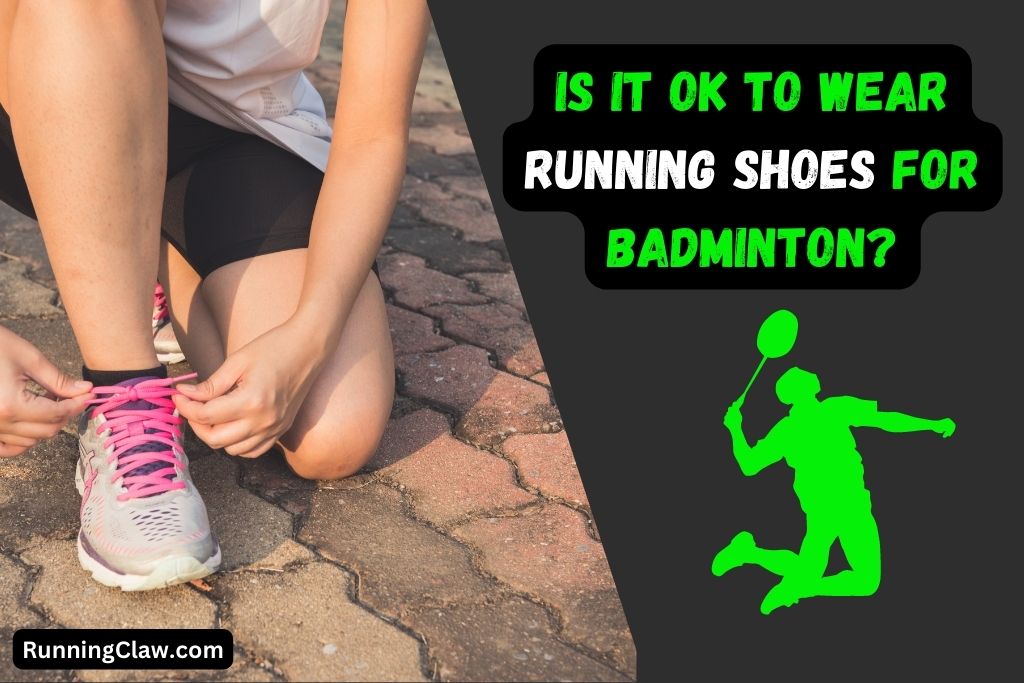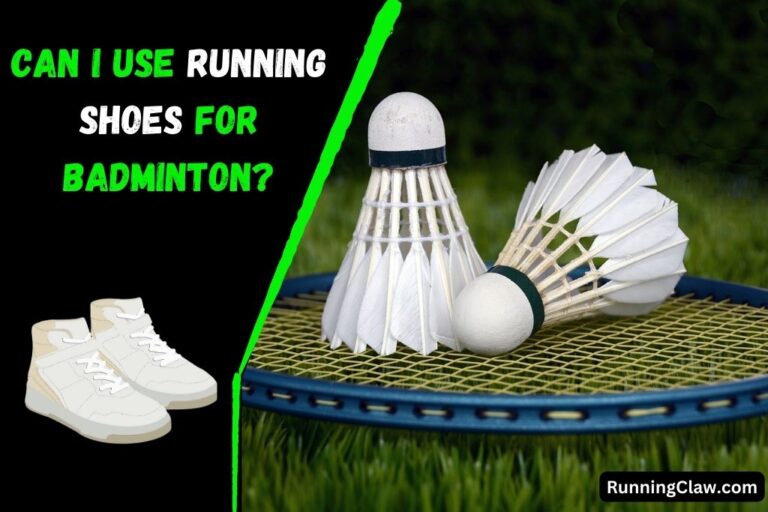Badminton is a sport that is considered relatively easy to play. Regular physical activity can have several benefits, including improving cardiorespiratory endurance, promoting muscle growth and strength, and potentially enhancing social interactions.
Many people are unaware of Badminton’s physical demands and intensity, which requires a high activity level.
I have seen many people wearing different kinds of sneakers for playing Badminton, including Running Shoes. BUT???
IS IT SAFE TO USE RUNNING SHOES FOR BADMINTON?
In this article, I will guide you all about using Running Shoes for Badminton and its Pros and Cons.
Read the whole article to get your queries clear regarding badminton shoes.
Difference Between Running Shoes and Badminton Shoes

Ah, the age-old debate of badminton shoes versus running shoes!
Let me tell you, my friend, there are quite a few differences between these two footwear options. So, buckle up and prepare for an engaging exploration of the contrasting worlds of badminton shoes and running shoes! Ah, yes! Unsurprisingly, these things serve different purposes and cater to various activities.
When it comes to comparing these two shoes, it’s like comparing night and day! They couldn’t be more different in almost every aspect. Regarding Badminton and running shoes, it’s like comparing apples and oranges!
These two types of footwear couldn’t be more different. Let’s dive into the fascinating world of sports shoes and explore the striking dissimilarities between badminton shoes and running shoes. Hey there! So, guess what? I own both pairs of shoes you’re interested in. And let me tell you, you should know a few things about them. Trust me; you won’t want to miss out on this!
Here are a few main differences:
Soles:
This is one of the biggest differences, without any doubt. This difference is explained further.
The thickness of Soles:
Regarding sole thickness, running shoes exhibit a greater thickness and enhanced durability. In contrast, badminton shoes are designed with thin insoles and outsoles. Multiple underlying factors drive the intentional execution of this action.
Using a thin sole in badminton footwear enhances the ability to perceive tactile feedback from the ground during gameplay. In the sport of Badminton, numerous explosive movements are required to be executed. Enhancing the ability to perceive ground contact can significantly amplify explosive power.
In running shoes, it is advisable to incorporate thicker soles to minimize the sensation of ground impact. This product is designed to provide protection and alleviate discomfort in your feet during prolonged running sessions.
Materials Used for Soles:
The soles of badminton shoes and running shoes are composed of distinct materials. The soles of badminton shoes are typically constructed using gum rubber, while the soles of running shoes are commonly made from rubber. There are notable distinctions between gum rubber and rubber. Both materials are composed of rubber, although they are distinct in their specific types.
The gum rubber material exhibits increased softness, reduced thickness, enhanced flexibility, and decreased durability compared to the rubber commonly employed in running shoe manufacturing. In addition, it is common for gum rubber to have a yellow colouration.
The soles of running shoes should be constructed using durable rubber material, as they are predominantly utilized in outdoor environments and are subjected to extensive mileage. Badminton is significantly surpassed in terms of various aspects. Using badminton shoes for running would result in significantly faster wear and tear than running shoes.
The Flexibility:
Flexibility is a crucial aspect in the context of Badminton. Both your body and your shoes are important factors to consider. In comparison to running shoes, badminton shoes exhibit a higher degree of flexibility. The presence of numerous fast-paced movements in Badminton necessitates the need for various types of such actions.
Footwear needs to possess the capability to conform to the unique contours of an individual’s feet, regardless of the specific range of motion involved.
The range of movements in this category consists of lunges, jumping, sidestepping, and other similar actions. Flexible shoes enable individuals to execute rapid movements with enhanced comfort and increased speed.
In contrast, running shoes typically exhibit limited flexibility due to their lack of necessity for it. During running activities, individuals typically maintain a straight trajectory. The movements consistently exhibit similarities.
The required manoeuvring or direction changes will be minimal. In contrast to Badminton, the player must swiftly change direction from left to right to successfully intercept a shot.
Is It OK to Wear Running Shoes for Badminton?

Badminton and Running Shoes are different and have different uses as well. They may look similar but have different purposes.
Badminton shoes are specially designed to provide traction, support and stability, which is required for playing Badminton. Moreover, they provide quick movements and lateral motions as well. Badminton shoes frequently feature non-marking soles, enhancing indoor courts’ traction.
While on the other hand, Running Shoes are specifically designed for forward motions and movements. Badminton shoes generally feature thicker soles and are not specifically designed to optimize multidirectional movements.
Wearing running shoes during badminton activities can heighten the likelihood of slipping, compromised stability, and potential foot and ankle injuries due to insufficient support.
Hence, it is commonly advised to utilize appropriate badminton footwear while engaging in the sport of Badminton. The shoes have been specifically engineered to optimize performance, mitigate the likelihood of injuries, and deliver the essential support required to meet the sport’s unique requirements.
Investing in a pair of badminton shoes can yield significant advantages in enhancing your overall playing experience and ensuring your safety during gameplay.
Can I switch between them?

My answer is a Straight NO!!!
It is not recommended to wear badminton shoes and running shoes interchangeably. When participating in a running activity, it is advisable to wear appropriate running shoes. Similarly, when participating in a game of Badminton, it is recommended to wear suitable badminton shoes. Wearing running shoes while playing Badminton poses a greater risk compared to utilizing badminton shoes for running activities.
If you play Badminton in Running Shoes, ultimately, you will sprain or twist your ankles. It is because of the height of hells that running shoes have. In addition, playing Badminton in running shoes is also uncomfortable. The current design lacks sufficient flexibility to accommodate the various movements typically performed during a game of Badminton.
On the other hand, wearing badminton shoes for running can also get you an injury. As it is commonly understood, badminton shoes are equipped with thin soles. Extended periods of running or jogging can lead to discomfort and pain in the feet.
In addition, engaging in running activities can lead to accelerated deterioration of the delicate soles of your badminton shoes. This holds particularly true when engaging in outdoor running activities on concrete surfaces.
To maximize the lifespan of your badminton shoes, it is advisable to restrict their usage to badminton courts exclusively and handle them cautiously.
Also Read:
Can Running Shoes be Used for Other Sports?
Recommendations:

Here are some of my top picks for Badminton.
Victor A970Ace:
The category of the best performance shoe stands out among the leading badminton brands. Recently, I have revised my perspective on the overall best performer.
After acquiring the Yonex SHB 65Z3 badminton shoes, I have developed a strong affinity for this particular model. However, upon recently evaluating the Victor A970Ace shoes, which are utilized by renowned players Lee Zii Jia and Anders Antonsen, I have determined that this alternative option is more compatible with my foot structure.
The shoe exhibits a slight reduction in width towards the front, providing a marginally enhanced level of protection at the base of the big toe and the front region where the toes come into contact with the shoe during forceful lunges executed to defend a closely positioned net shot. This observation was particularly evident during the execution of front-court drills.
Simultaneously, the midsole imparts a perceptibly enhanced cushioning sensation beneath the foot compared to the 65Z3.
Despite being constructed using different technologies, the grip underneath the outsole and other areas in which they compete exhibited comparable levels of quality. This document presents a comprehensive analysis and evaluation of the Victor A970Ace.
Perfly BS530:
Choosing a cost-effective, top-performing badminton shoe can be challenging due to the necessity for brands to make certain compromises to offer it at a desired price point.
It has been observed that companies striving to increase their market share often exhibit a heightened level of effort to impress customers. Consequently, it is advantageous to consider such brands when seeking additional benefits. The issue lies in identifying brands, particularly those not as well-known as Yonex.
One illustration is the Perfectly brand of badminton equipment from Decathlon. I occasionally used their Perfly BS 530 shoe, which retails for about $40 here in Vietnam, for about six months, and I was satisfied with them. Compared to the Yonex shoe I bought subsequently, they provided good value for the money and didn’t break.
The Perfly BS 530 features enhanced padding on the shoe’s outer layer, specifically on the foot’s inner side. This design improvement aims to enhance the shoe’s durability during lunges and movements that involve the non-racket leg for better control.
Additionally, the shoe has a non-marking indoor sole, a mandatory feature in most venues. The shoe exhibits a moderate shock absorption level, aligning with its corresponding price point. However, it does not possess any exceptional qualities in this regard. The difference is minimal compared to Yonex’s Precision 1 and other budget shoes.
This particular badminton shoe stands out as the most optimal choice within a budget range, based on my personal experience. If I needed to begin anew and acquire an additional budget-friendly shoe, I would likely opt for the same one again.
Conclusion:
To Conclude, investing in a pair of shoes required for a specific sport is always better. If you want to enhance your performance and reduce the risk of injuries while playing tennis, Buy a pair of Badminton shoes and avoid playing in other normal sneakers.
Related Articles:
- How to Make Cleats Smell Better?
- What Sports Can Use Metal Cleats?
- Soccer Cleats Vs. Football Cleats
- Can Soccer Cleats Be Used for Football?
- Do Professional Soccer Players get Free Cleats?
- Can Soccer Cleats Be Used for Football?
- Do Puma Soccer Cleats Have A Warranty?
- What is The Difference Between Shoes and Cleats?
- Difference Between Soccer and Football Cleats


